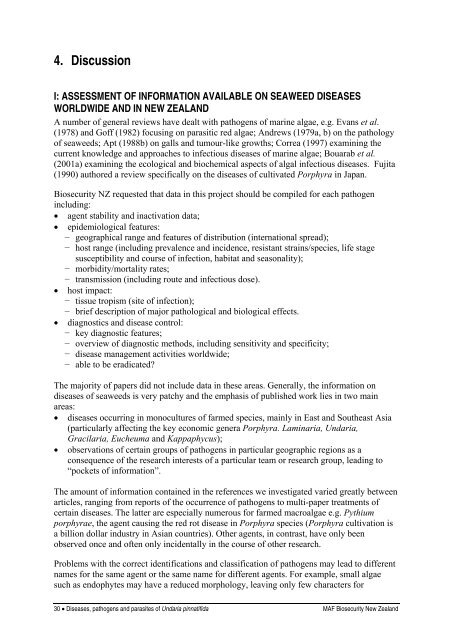Diseases, pathogens and parasites of Undaria pinnatifida
Diseases, pathogens and parasites of Undaria pinnatifida
Diseases, pathogens and parasites of Undaria pinnatifida
Create successful ePaper yourself
Turn your PDF publications into a flip-book with our unique Google optimized e-Paper software.
4. Discussion<br />
I: ASSESSMENT OF INFORMATION AVAILABLE ON SEAWEED DISEASES<br />
WORLDWIDE AND IN NEW ZEALAND<br />
A number <strong>of</strong> general reviews have dealt with <strong>pathogens</strong> <strong>of</strong> marine algae, e.g. Evans et al.<br />
(1978) <strong>and</strong> G<strong>of</strong>f (1982) focusing on parasitic red algae; Andrews (1979a, b) on the pathology<br />
<strong>of</strong> seaweeds; Apt (1988b) on galls <strong>and</strong> tumour-like growths; Correa (1997) examining the<br />
current knowledge <strong>and</strong> approaches to infectious diseases <strong>of</strong> marine algae; Bouarab et al.<br />
(2001a) examining the ecological <strong>and</strong> biochemical aspects <strong>of</strong> algal infectious diseases. Fujita<br />
(1990) authored a review specifically on the diseases <strong>of</strong> cultivated Porphyra in Japan.<br />
Biosecurity NZ requested that data in this project should be compiled for each pathogen<br />
including:<br />
• agent stability <strong>and</strong> inactivation data;<br />
• epidemiological features:<br />
− geographical range <strong>and</strong> features <strong>of</strong> distribution (international spread);<br />
− host range (including prevalence <strong>and</strong> incidence, resistant strains/species, life stage<br />
susceptibility <strong>and</strong> course <strong>of</strong> infection, habitat <strong>and</strong> seasonality);<br />
− morbidity/mortality rates;<br />
− transmission (including route <strong>and</strong> infectious dose).<br />
• host impact:<br />
− tissue tropism (site <strong>of</strong> infection);<br />
− brief description <strong>of</strong> major pathological <strong>and</strong> biological effects.<br />
• diagnostics <strong>and</strong> disease control:<br />
− key diagnostic features;<br />
− overview <strong>of</strong> diagnostic methods, including sensitivity <strong>and</strong> specificity;<br />
− disease management activities worldwide;<br />
− able to be eradicated?<br />
The majority <strong>of</strong> papers did not include data in these areas. Generally, the information on<br />
diseases <strong>of</strong> seaweeds is very patchy <strong>and</strong> the emphasis <strong>of</strong> published work lies in two main<br />
areas:<br />
• diseases occurring in monocultures <strong>of</strong> farmed species, mainly in East <strong>and</strong> Southeast Asia<br />
(particularly affecting the key economic genera Porphyra. Laminaria, <strong>Undaria</strong>,<br />
Gracilaria, Eucheuma <strong>and</strong> Kappaphycus);<br />
• observations <strong>of</strong> certain groups <strong>of</strong> <strong>pathogens</strong> in particular geographic regions as a<br />
consequence <strong>of</strong> the research interests <strong>of</strong> a particular team or research group, leading to<br />
“pockets <strong>of</strong> information”.<br />
The amount <strong>of</strong> information contained in the references we investigated varied greatly between<br />
articles, ranging from reports <strong>of</strong> the occurrence <strong>of</strong> <strong>pathogens</strong> to multi-paper treatments <strong>of</strong><br />
certain diseases. The latter are especially numerous for farmed macroalgae e.g. Pythium<br />
porphyrae, the agent causing the red rot disease in Porphyra species (Porphyra cultivation is<br />
a billion dollar industry in Asian countries). Other agents, in contrast, have only been<br />
observed once <strong>and</strong> <strong>of</strong>ten only incidentally in the course <strong>of</strong> other research.<br />
Problems with the correct identifications <strong>and</strong> classification <strong>of</strong> <strong>pathogens</strong> may lead to different<br />
names for the same agent or the same name for different agents. For example, small algae<br />
such as endophytes may have a reduced morphology, leaving only few characters for<br />
30 • <strong>Diseases</strong>, <strong>pathogens</strong> <strong>and</strong> <strong>parasites</strong> <strong>of</strong> <strong>Undaria</strong> <strong>pinnatifida</strong> MAF Biosecurity New Zeal<strong>and</strong>

















